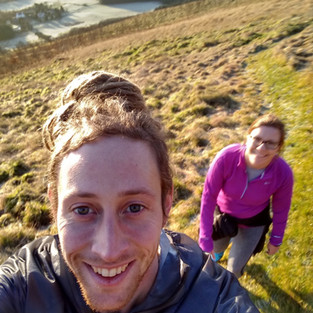
Running, for many, is a solitary sport and it is usually only at races where all the long-distance specialists come out of the woodwork to create a temporary rally of buzzing, pumped up, carbo-loaded trail junkies. Save for the fleeting moments when you pass another runner in the middle of the forest or on top of the mountain and mark the moment with some kind of acknowledgement, be it smile, grunt or flick of the head.
Recently, however, things have been different, and there has been a surge of new and old runners returning to the sport, which is great. However, since we are locked in our local regions, suddenly it has become quite a job to say hi or acknowledge everyone with smile. So, to spice up my long hours of training for my first hundred miler I decided to don my lightweight racing lab coat and smile until my jaw hurt.
We’ve all seen the images of top runners grinding up hills (namely Emilie Forsberg) after hours and kilometres on the go with massive smiles on their faces before going on to win or podium. This got me thinking. Seemingly, smiling can improve your running performance! A team of sport scientists (Brick et al 2017) carried out an experiment on 24 trained runners, who did 6-minute repeats at 70% velocity at V02 max. They had two minutes rest between intervals and they randomly pulled a bunch of different faces while running. This must have been one of the most entertaining experiments to watch ever. I’d love to see that footage! Frowns, smiles, normal running face (control) and making an effort to relax their upper body were all added to the 6-minute blocks and the corresponding oxygen consumption and perceived effort were measured. It showed that both the previous variables were lower in smiling runners thus optimising movement economy while running.
I highly recommend giving it a shot during high intensity workouts because it really works. I often smile and grin my way through the final reps in a series or laps of a hill to make the suffering slightly more bearable. It’s like an immediate mental hack into extra energy reserves. Anyway, back to my highly scientific smile-a-thon. I classified four different approaches that had varying results, which were measured by a returned smile.
1. A quick wave and a smile
2. A nod of the head and a smile
3. A hello and a smile
4. Only a smile
Any method worked with the seasoned trail runners, who spend most of their time on Strava giving kudos anyway, and so are happy to throw down smiles like miles. On the other side, with walkers, dog walkers, birdwatchers and people new to the sport quite the opposite could happen. Only a smile, strangely, had a pretty poor response with the majority of people looking caught off guard or quickly thinking where they knew me from. Fortunately, I find this moment of awkwardness between two total strangers rather funny and a great boost to running performance, especially when going uphill. A similar response rate was seen with the head nod and smile with people unsure of how to respond, flabbergasted or overwhelmed by the sudden over stimulation during their peaceful walk in the trees. A hello and smile work effectively for all but the most serious runners, in the grips of a V02 max workout and too deep into the lactate to do anything except sweat and grunt. The best method seemed to be the wave and smile, which is what I’ve decided to settle on for now.
So, the proof is in the pudding. Get out there and smile, trigger the endorphins and increase your running economy. And if it’s all going south, fake it until you make it because you might brighten up someone else’s day at the very least!
Brick, N.E., McElhinney, M.J., Metcalfe, R.S., The effects of facial expressionand relaxation cues on movement economy, physiological, and perceptual responses during running,Psychology of Sport & Exercise (2017), doi: 10.1016/j.psychsport.2017.09.009.






















